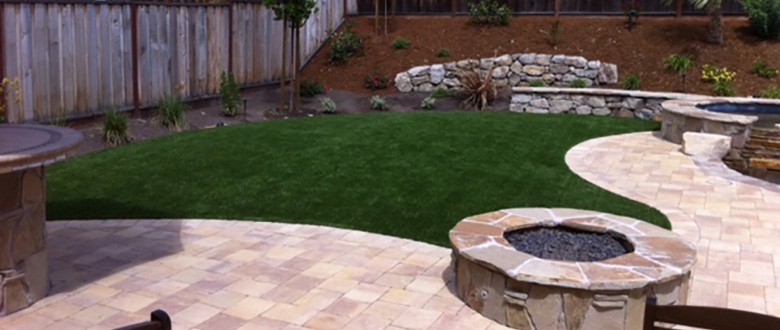In a time when the earth’s resources seem to be diminishing with each passing year, it is important that we all become environmentally conscious and make changes to further reduce environmental damage. Many people don’t realize a traditional yard (which requires constant maintenance) is an environmental hazard. The water, chemicals and gas-powered lawn tools used for care poison the planet. They also thwart water conservation efforts. One of the most effective, environmentally beneficial remedies is replacing your yard with an artificial grass lawn. Artificial grass benefits the environment in several ways. Let's explore further.
3 Key Artificial Grass Benefits for the Environment
CONSTANT CARE AND CHEMICALS
If you want to have a lusciously green yard it takes work. Prepare for continuous care, pest issues and money out of your pocket. The only way to deal with those issues involves fertilizers, pesticides, and other chemicals. These lab-created products ward off pests. They make your lawn grow 2x faster. They make it greener. However, where do all of these chemicals go afterward? They end up as runoff in our local streams, rivers ponds, and lakes. Pollutants left over from this fertilizer runoff cause algae blooms. These grow so large they block waterways. Over time, the algae blooms die and remove oxygen from the water.
This creates deadzones, a growing issue in the United States and around the world. The use of chemicals in lawn care is poisoning of aquatic life. According to the U.S. Center for Disease Control (CDC), Americans use roughly 75 million pounds of pesticides each year to ward off pesky bugs and critters. When these chemicals make their way into our streams and waterways, the fish ingest them and become diseased. Humans eating the fish may become ill. It is a terrible cycle we must end. Artificial grass lawns require no pricey fertilizers or pesticides. You might see a few bugs here and there, but most go away. The reason? Insects thrive and feed where nutrients are present. Artificial grass provides none of these. Bugs tend to go elsewhere while you enjoy a virtual pest-free environment.
SAVE THE WATER
Everyone knows how important water is to our world. Artificial grass benefits serve as a one-two environmental punch in this regard. As mentioned above, the use of fertilizers, pesticides and other chemicals for lawn maintenance poison our streams and water supplies. Traditional lawn care fails in the water conservation department, too. According to the Environmental Protection Agency, the average family typically uses 320 gallons of water a day. Approximately 30% of that is devoted to outdoor use like watering your lawn. Nationally, residential landscape irrigation accounts for almost one third of all water use. That totals nearly 9 billion gallons per day. In additon, researchers in Minnesota have found that people are waste large amounts of water because they don’t understand how to properly water their lawn. They also note newer sprinkler systems share part of the blame.
The main issue is water shortage and its impact on resources like lakes and wetlands. Removing your old, high-maintenance yard, and replacing it with a fresh, artificial grass lawn decreases water waste and consumption. There is no need to water artificial grass and no need for sprinkler systems. They require minimal maintenance. Switch to an artificial grass lawn and watch your water bill drop!
LIGHTEN YOUR FOOTPRINT
Despite lawn care being a good workout, it can end up being a cumbersome weekly project. Not only does it wear on the person putting in the work,but it is also increases your carbon footprint. A carbon footprint is a measure of greenhouse gas emissions a person (or family, organization, company, etc.) creates in the environment. Many of our daily activities, such as driving a car, mowing the lawn, and using electricity all cause greenhouse gas emissions, and while you may feel that your mowing once a week could cause minimal damage, you might be surprised to learn that just one hour of mowing causes as much pollution as a 100 mile car trip.
According to the study, National Emissions from Lawn and Garden Equipment in 2011, approximately 26.7 million tons of pollutants emitted from GLGE (Gasoline Powered Landscape Maintenance Equipment). Moreover, these gasoline powered landscape equipment, ranging from weed eaters and mowers to grinders and tractors are a source of high levels of localized emissions that include pollutants, criteria pollutants, and adverse health effects of the exhaust emissions, such as cardiovascular disease, stroke, cancer, neurological conditions, and other health issues.
Final Thoughts on Artificial Grass Benefits
Traditional grass lawns cause environmental damage. They require chemicals for upkeep, lawn tools that pollute the air and do little for water conservation. Artificial grass benefits are obvious in light of these facts. We need to make strides toward water conservation, and end the use of chemical based pesticides and fertilizers. The health of our local wildife, natural resources and communities are at stake. .
Then there are the practical artificial grass benefits. Switching to artificial grass will save you hours of lawn work and money. Your water bill decreases and the need to buy expensive lawn equipment disappears. Also, you can feel proud that by getting rid of that old yard and installing a gorgeous, maintenance-free artificial grass lawn, you are decreasing your carbon footprint and truly making a positive environmental impact for our world.
GOT A QUESTION? ASK US!


